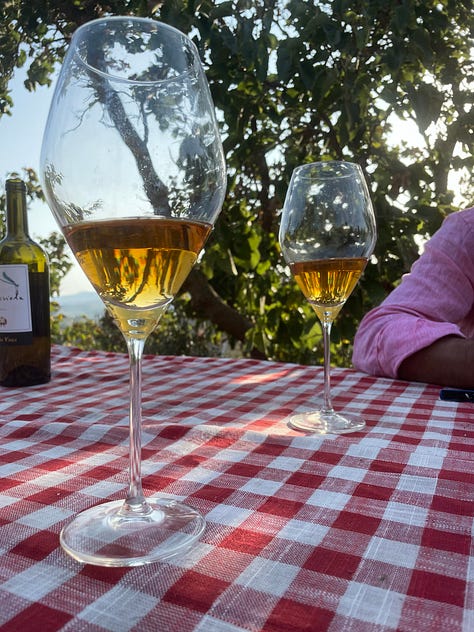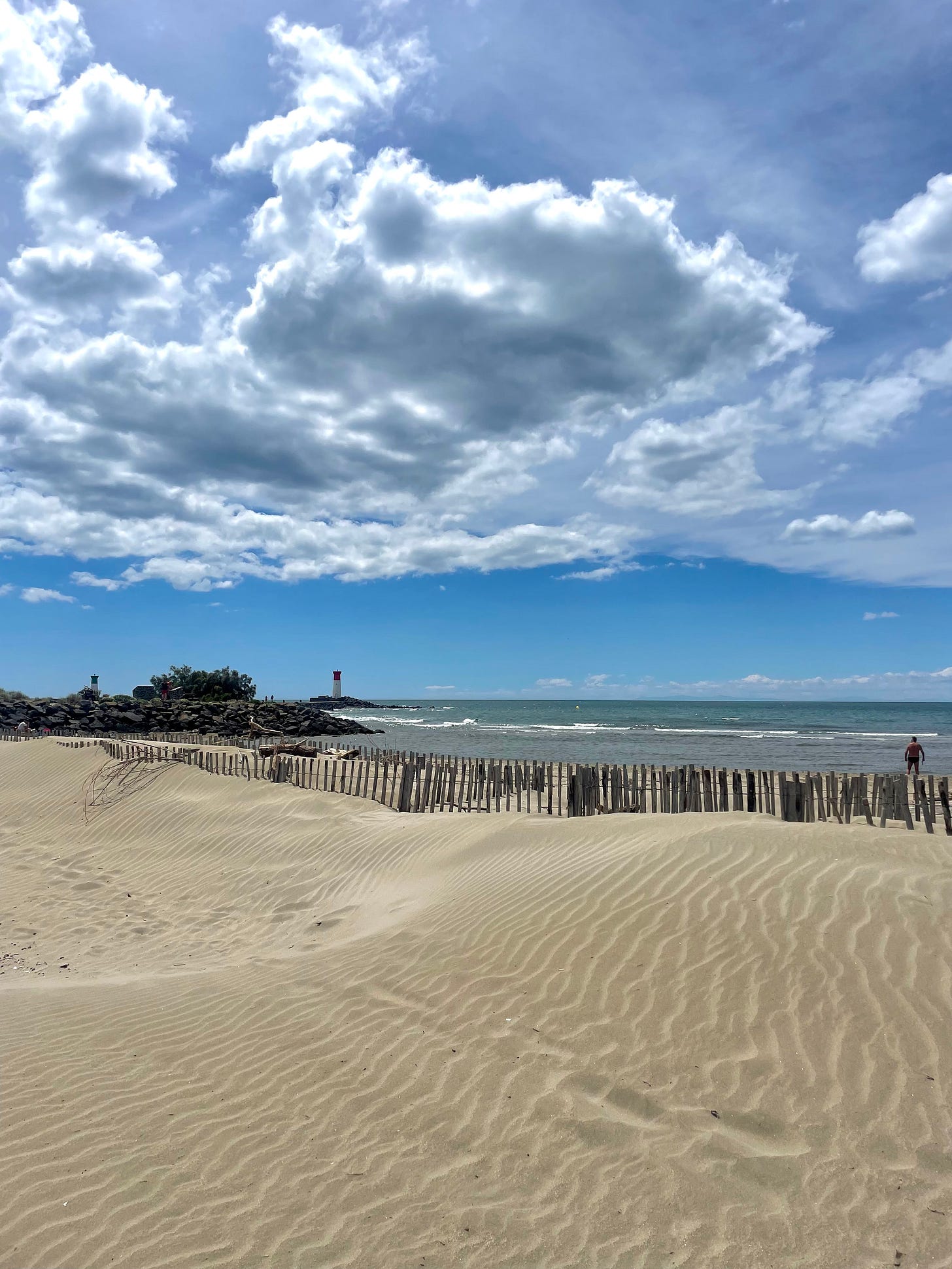September, Septembre | Love language, la discothèque nudiste and skin contact
My celebration for the alternative side of French culture
This month is inextricably bound to that back-to-school vibe, otherwise known as la rentrée in French. My body often bristles with the opposing forces of excitement and melancholy, tied to the inevitable end of beach naps and glorious blue skies but which are wrapped in the silver lining of anticipation for the surge of commotion and newness that these next months bring.
I cannot really fathom that I have been living in France since May and I have been trying to reflect on what, if anything, I have learnt or achieved in these months. In fairness, I rolled into September somewhat more bronzed, plump and relaxed than I have been in a long time, which I can only take as an achievement of sorts, surely? One friend enquired whether I had read Orwell’s Down and Out in Paris and London, before stating, “I can see you living a modern version - your tales of boys, booze and boats.”. Indeed, intrigue into my sexcapades and handsome winemakers has been rife. Perhaps there is something about the culture of France that permeates this sense that everyone is doing it and that there is something undeniably sexy in the air. I am undecided as to whether these questions and assumptions are due to my alluring prowess or whether many of you are, in fact, living out your illicit fantasies through me..?
Whichever it is, this month’s newsletter is dedicated to all you inquisitive deviants and to the handful of things that I have managed to learn during my long, hot summer in France.
Le langage de l’amour
At the top of the list is that my French has improved. I realise that this is not revolutionary to many (or any) of you and probably is the bare minimum that you’d expect from me, but this summer has been revolutionary in the methods to get there. Genuinely, if you want to learn a language, I would forget the radio, TV or picking up a newspaper, and get into the grit of daily life:
Start light by having gentle yet flirtatious banter with your green grocer. This is a good way to practise your day-to-day chit chat, learn about different foods and explain why you’re not married and don’t have children at 36.
Now, a very useful tool in getting you on board with the coarser side of the language and the French-y hand and shoulder gestures one should use to really hammer home a point is the good old fashioned fight. Also great for helping you to practise your language under duress. This summer, I have had one public restaurant fight and two neighbourly street spats, which I would say have been greatly beneficial.
Probably most pivotal to my language development has been spending time with my mother who speaks no French and has thrown me into highly complex situations with no warning or context; insurance claims, scam calls, niche engineering conversations or anything to do with French bureaucracy.
This journey of mastering la langue and the general communication style of the French is a rocky path. Bar the language itself, there is a certain insouciance that encapsulates the French way; the look, the shrug, the puffed cheeks and the inevitable judgement. Their daily transactions are also more black and white, more direct; whereas us Brits like to add a touch of pomp and ceremony with verbose questions, the French simply state their wants and needs. Here are some tips on cutting to the chase next time you’re in France:
Would it be possible to have a croissant? Je veux un croissant. I want. It is simple as that.
May I have a beer? Donnez-moi une bière. Give me. This bristles my polite English sensibility but I try to push through for the authentic French experience.
Up your flirting by ditching the uncomfortable, rambling English charm with the direct j’ai envie de toi. I want you. There is a reason the French are so romantically successful.
La discothèque nudiste
This final point is a nice segue into my next learning breakthrough regarding France. For a little bit of background context; I was partaking in a geriatric sunset game of pétanque when I happened to mention that I was repeatedly being pinged on a dating app from gentlemen 12-13 kilometres away who were staying in the next town along, Agde. The fact that these men were staying in Agde seemed to suggest something that I was unaware of, as their location was normally followed by a winky face or some other suggestive emoji. A very nice man casually explained - whilst pétanque-ing - that it was probably something to do with the nudist sex colony in Cap d’Agde. Bien sur.
For research purposes of course, I did a little digging and yep, it turns out that whilst I have not been naked frolicking, there has been a lot of it going on right under my nose, namely at a club called Le Glamour Club. This is in fact Europe’s largest sex club and a celebration of France's clearly thriving libertine culture. The club forms a whole naked ecosystem of beach bars, restaurants and shops.
Now, because I am a classy woman and a history graduate, I thought I’d give you a little background. The concept of a libertine was born in the 18th century to describe a person who pursued happiness, pleasure and personal freedom, eschewing the constraints of religion and societal norms. Perhaps not surprisingly, this new subversive culture coincided with the growing body of literature and art that focused on eroticism and the pleasures of the body. Fast forward a few hundred years and this libertinage wave is something that feels ingrained in the sex appeal of the French with all of their free-thinking and rampant love-making. However, after striking up a few conversations with my French peers, it would appear that this libertine sense is definitely a mirage of the wider culture.
I feel that I should caveat that I did not make it to the club this summer but if any of you feel that we should go as a way of exploring the modern day iteration of this 18th century phenomenon, so as to really understand French culture, please just let me know.
A fittingly sexy wine
Skin contact. Undoubtedly the most suggestively named of the wine types. Somewhat less suggestive, it may also be called orange wine, macerated wine or indeed, amber wine.
When people are unsure about this golden-hued sub-category of the humble white wine, I argue that it is the OG white wine. Orange wine was in fact the only white that existed before we got all technical and flashy pants. The crystalline bottles of water-coloured wine that fill our supermarket shelves are a very modern creation. In its simplest form, skin contact wine is simply white wine made in the same way that we make red wine - by keeping the skins in contact with the juice, or macerating the skins with the juice. As the skins of a white grape are never white exactly, but in fact a varying array of yellow, green, gold or even pink and grey (something I will touch on later), the resulting orange wine is a heady mix of whatever colour the grapes’ skins are. So whether skin-contact, macerated, orange or amber, this wine really does just do what it says on the tin (bottle).



Aldo Viola, Sicily | Chai des Mimosas, Roussillon | Andreas Tscheppe, Styria
However, this act of skin contact can result in a tremendously different wine depending on the length of the maceration. If you are confused about this process, I urge you to think of a cup of tea; the longer you dunk, stir and squeeze that little tea bag, the more deeply coloured and intensely flavoured your cup of tea will invariably be. Wine is no different. Now, some winemakers choose to use a soupcon of skin contact to add some body and structure to their wine but will do little to change the colour of the actual wine. However, you can also choose to leave the skins in with the juice for weeks or even months which will create wines that range from sunny yellow all the way to a deep-irony copper.
I feel that this is where I should address the pinky-grey grapes I mentioned earlier. This is not some niche wine thing that I am going to tell you about so as to flex my deep knowledge. Far more fun in my opinion; this is something you definitely know about but maybe just don’t really know about. I am being cryptic and probably a bit annoying at this stage. Ok, so if I was to say Pinot Grigio, I think we would also know what I am talking about. Pinot Grigio in Italy. Pinot Gris in France. What you see on the shelves of a supermarket would make you think that these grapes are no different to any other white wine. However, they are. The gris-grigio part of the name is a reference to its grey skins, which sounds terrible, but encapsulates this ethereal pinky-grey colour that these grapes naturally have. A skin-contact wine from these coloured skins creates this peachy-honey colour that genuinely makes you feel like you’re living in an endless sunset and unsurprisingly, pairw very well with sunsets (and anchovies on toast and the occasional holiday ciggie after a post-beach shower). As you can ascertain, I am a moderate fan. Now for a little knowledge flex; if you make a skin contact with Pinot Grigio in Italy’s northern region of Friuli, it can be labelled Ramato. These wines are far from common so I highly recommend giving them a go if you come across a bottle.
As well as the colour scheme being different, you are also going to find a whole host of different smells and flavours that can include peach, apricot, guava, pink grapefruit, orange peel, cinnamon, clove, allspice and of course, many many more. On the nose, some people can find the wine momentarily jarring because it sometimes reminds them of the lusciously scented sweet wines, but on the palate, the wine is far from sweet.
Despite this wine basically being by namesake, I am not trying to hard sell it to you. But if my fascinating descriptions, deep knowledge and emotive sunset push hasn’t won you over, let me say one more thing - skin contact is a ridiculously good match for so many foods including from the trademark British Sunday roast to the British favourite of curry.
So, from one aspirational libertine to another, may we all enjoy the pleasures of skin contact in its many forms until we meet again next month.
Santé x





What a gift that I’ve found your Substack! Please visit the colony for journalistic purposes.